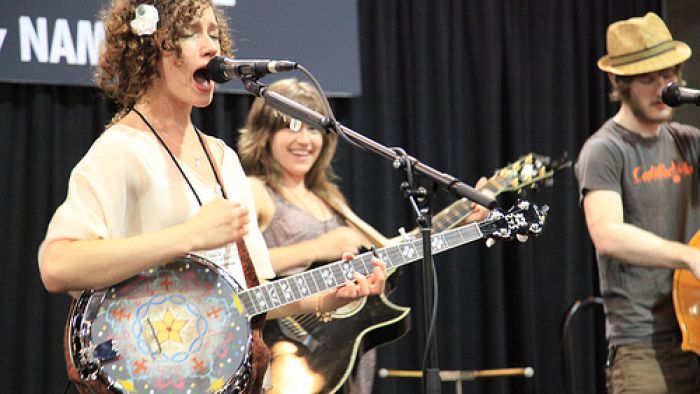Folk and Bluegrass Instrument Boom Rocks NAMM in Nashville

Revival of traditional bluegrass and folk instruments fueling music retail as banjos, mandolins and other acoustic sounds permeate all musical genres
A colorful, populist revival is underway for traditional bluegrass and folk instruments according to current sales trends and anecdotes from retailers. The hallmark instruments of this resurgent sound promise to be a dominant force at Summer NAMM, held July 11, 12 and 13 in Nashville at the brand new Music City Center. Growing demand is being fostered by steady stream of Top 10 tunes richly embroidered with bluegrass and folk sound via artists such as Taylor Swift, Mumford & Sons, and even Steve Martin. Retailers, responding to the trend, will be at NAMM looking to fill their shelves with banjos, mandolins, acoustic guitars and related instruments in time for the coming holiday.
“This is a trend that has certainly got legs,” said Ryan Bouslaugh, marketing/artist relations for Two Old Hippies. “Sales of these types of instruments are probably the strongest growth in the industry right now, and it’s going to be around for awhile.” Two Old Hippies is the parent company of Breedlove Guitars, Bedell Guitars, and Weber Fine Musical Instruments.
According to recent figures, sales of acoustic instruments have been on the rise for the last four years. Since 2009, the acoustic guitar category, which includes the mandolin family, banjos, resonators and other stringed, fretted instruments has risen approximately $141 million, or 36 percent.
Bruce Weber, founder of Weber Fine Musical Instruments, attributes the trend in part to some current entertainers’ willingness to reach into other genres to enrich their sound. “The demand for acoustic instruments has quietly built to its recent explosion as established entertainers such as Sheryl Crow and Gene Elders (George Strait’s band), as well as up-and-coming musicians like Sierra Hull, SHEL and The Band Perry, look for a new sound -- really an old sound -- to give flavor and a new/old personality to their music,” Weber said. “Demand for mandolins, mandolas, octaves, and the like has never been so great.”
The signature of this trend is its stealthy pace, which accelerated slowly as bluegrass and folk sounds found their way into mainstream popular music. It was then spurred by a faltering economy that oriented people to more grassroots entertainment forms. According to Carolina Bridges of the Deering Banjo Company, the economic downturn stoked the slow-burning trend.
“What we observed here at Deering was that folks returned to their interest in acoustic instruments for entertainment and personal fulfillment. Here was something that you could invest in that the whole family could enjoy together whether you were the player or the listener,” Bridges said.
Barry Hunn, Deering’s world-wide sales manager said his company has seen a steep increase in the number of sales world-wide since 2010 and a dramatic upswing in 2011 through 2012. “We feel that the banjo will maintain this high level of interest moving forward and we do not feel that the pinnacle of interest in the market has even been reached.”
While some musical instrument trends are boosted in part by innovations to the instruments themselves, this solid trend appears to be fattened on a steady diet of sheer enthusiasm, and, as Dennis Vance of The Mandolin Store in Arizona puts it, the growing appreciation for acoustic instruments across the generations.
“People are passionate about their acoustic instruments,” Vance said. “The acoustic, stringed family is growing, probably because musicians, being a creative group, are constantly looking for new, unique outlets for their talent, and choosing from the larger instruments in the mandolin family -- the octave and the mandola -- is a natural thing,” Vance said. “These trends can come in waves. The electric, amplified music of the 70s and 80s will probably swing back, but the young acoustic players seem to stay with it and the long-time acoustic players are very loyal,” he said. “They’ll spend on an instrument before they’ll spend on a vacation.”
Bruce Weber concurs, citing the accessibility of traditional bluegrass and folk music as a reliable predictor of the trend’s longevity. “As people listen and relate to the emotions easily evoked by the clean, yet extraordinary sound in acoustic music, they are undoubtedly drawn to those instruments,” he said. “Some of the current musicians have blown the idea that these instruments are confined to a certain musical genre out of the water, drawing everyone from old rockers to amazingly talented young grunge players to the acoustic family.”
The folk and bluegrass trend is in full swing and will be on hand for retailers and the music industry to preview, hear and demo at Summer NAMM in Nashville. With brands such as Deering, Weber, Gold Tone, Gatchell Violins Company, Schubb, Eastman Mandolins and Guitars, Taylor Guitars, C.F Martin & Co, Bedell and Breedlove Guitar Company, Nashville’s Music City Center promises to be jamming with a wide variety of new instruments and accessories ready to fill music store shelves this fall and holiday.
Summer NAMM gathers members of the music product industry from around the world to preview new product debuts from brands across every category. Exhibit space is still available for the 2013 event. Learn more about the Summer NAMM Show here. See the directory of brands attending Summer NAMM: http://www.namm.org/summer/2013/directory. Members of the Music Industry can register online: http://www.namm.org/summer/2013/badges.
About NAMM
The National Association of Music Merchants (NAMM) is the not-for-profit association with a mission to strengthen the $17 billion music products industry. NAMM is comprised of approximately 10,300 members located in 104 countries and regions. NAMM events and members fund The NAMM Foundation's efforts to promote the pleasures and benefits of music, and advance active participation in music making across the lifespan. For more information about NAMM, please visit www.namm.org, call 800.767.NAMM (6266) or follow the organization on Facebook, Instagram and Twitter.